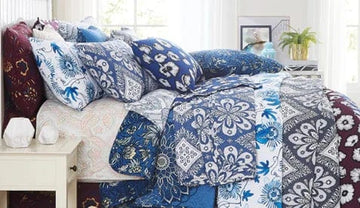How To Mix & Match Patterns For A Designer Bedroom
Mixing and matching patterns often scares people, even though they love the look. Fortunately, there’s no need to feel intimidated or settle for a boring bedroom. It’s actually quite easy to mix and match patterns when you follow these basic rules.
Choose the Vibe
Start by analyzing what feel you want in your bedroom. Do you love the femininity of florals? What about the quirkiness of animal prints?
Does the boldness of chevron prints, stripes, or polka dots appeal to you, or do you prefer the sophistication of herringbone or hounds tooth? What about the warmth of tartan or the playfulness of paisley?
Think about the overall look you want to achieve and the energy you want in the room. Patterns have personality. Busy patterns increase the energy level, while simple or soft patterns calm it.
Try a Theme
If you’re still overwhelmed with the possibilities, choose a favorite piece of furniture, an accessory, or even a pattern or color from your bedding.

For instance, if you love the red in this Boho Bloom reversible quilt set, you might want to choose a geometrically-patterned pillow in red. Conversely, if you like the geometry of this Infinity reversible quilt set, you might want to contrast it with a soft floral in gold or grey.

Think about what element appeals to you and why. Is it the soft flow of the form, the bold lines, or the color? Once you identify what you like about the item, use it as a starting point for your theme.
What Are You Trying To Do?
Consider whether you’re trying to draw the space together or you want to create a focal point on your bed. Large patterns tend to create harmony, while small patterns focus the eye.
Patterns don’t have to include many colors. You can still add depth and character to your bedroom with just a few.
Choose Equal Color Intensities
If you like a pastel blue pattern, don’t mix it with a fabric with a deep blue tone. Stick to the same hue and color intensity. It makes it much easier to make patterns work together.
When choosing whites, ensure they’re all in the same color family. Bright white, cream, and off-white all have distinct characteristics and mixing them doesn’t work. Start with a bedding collection with perfectly matched whites and then match the whites in your patterns to your bedding.
Pick Three Patterns
Show restraint and start with the minimum odd number of three. Choose the largest pattern first.
Next, choose your second pattern. The pattern size should be half the size of the first. If your first pattern was an organic pattern like a floral, your second should be bolder and more geometric, but pick up some of the same colors. If the first was geometric, choose an organic one.
Finally, choose your third pattern. It can echo the pattern or colors of either your first or second pattern, but should be a smaller size. For instance, if your first pattern was a large red floral, you might choose a smaller floral or a second geometric with red in the pattern.
Distribute Patterns Wisely
If you just want to add patterns to your bed, ensure they’re evenly weighted. Otherwise, your bed will look lopsided. Don’t pile too many patterns on top off each other. Break them up with solids so it doesn’t look chaotic.
Many people choose a solid quilt, comforter, or duvet and add patterned and solid pillows. However, you should carry bits of the color from your chosen patterns around the room or they can look lost on the bed.


*****
Southshore Fine Linens offers a full range of bedding products including solid, patterned, and textured bedsheets, quilts, and duvet cover sets in cotton and manmade fibers. We make designer bedrooms easy.



